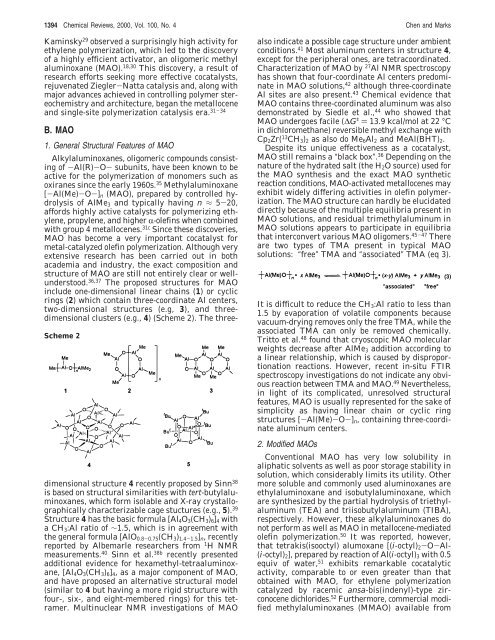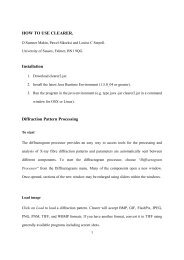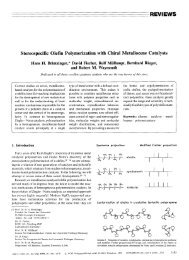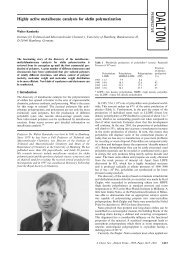Cocatalysts for Metal-Catalyzed Olefin Polymerization: Activators ...
Cocatalysts for Metal-Catalyzed Olefin Polymerization: Activators ...
Cocatalysts for Metal-Catalyzed Olefin Polymerization: Activators ...
You also want an ePaper? Increase the reach of your titles
YUMPU automatically turns print PDFs into web optimized ePapers that Google loves.
1394 Chemical Reviews, 2000, Vol. 100, No. 4 Chen and Marks<br />
Kaminsky 29 observed a surprisingly high activity <strong>for</strong><br />
ethylene polymerization, which led to the discovery<br />
of a highly efficient activator, an oligomeric methyl<br />
aluminoxane (MAO). 18,30 This discovery, a result of<br />
research ef<strong>for</strong>ts seeking more effective cocatalysts,<br />
rejuvenated Ziegler-Natta catalysis and, along with<br />
major advances achieved in controlling polymer stereochemistry<br />
and architecture, began the metallocene<br />
and single-site polymerization catalysis era. 31-34<br />
B. MAO<br />
1. General Structural Features of MAO<br />
Alkylaluminoxanes, oligomeric compounds consisting<br />
of -Al(R)-O- subunits, have been known to be<br />
active <strong>for</strong> the polymerization of monomers such as<br />
oxiranes since the early 1960s. 35 Methylaluminoxane<br />
[-Al(Me)-O-]n (MAO), prepared by controlled hydrolysis<br />
of AlMe3 and typically having n ≈ 5-20,<br />
af<strong>for</strong>ds highly active catalysts <strong>for</strong> polymerizing ethylene,<br />
propylene, and higher R-olefins when combined<br />
with group 4 metallocenes. 31c Since these discoveries,<br />
MAO has become a very important cocatalyst <strong>for</strong><br />
metal-catalyzed olefin polymerization. Although very<br />
extensive research has been carried out in both<br />
academia and industry, the exact composition and<br />
structure of MAO are still not entirely clear or wellunderstood.<br />
36,37 The proposed structures <strong>for</strong> MAO<br />
include one-dimensional linear chains (1) or cyclic<br />
rings (2) which contain three-coordinate Al centers,<br />
two-dimensional structures (e.g, 3), and threedimensional<br />
clusters (e.g., 4) (Scheme 2). The three-<br />
Scheme 2<br />
dimensional structure 4 recently proposed by Sinn 38<br />
is based on structural similarities with tert-butylaluminoxanes,<br />
which <strong>for</strong>m isolable and X-ray crystallographically<br />
characterizable cage stuctures (e.g., 5). 39<br />
Structure 4 has the basic <strong>for</strong>mula [Al4O3(CH3)6]4 with<br />
aCH3:Al ratio of ∼1.5, which is in agreement with<br />
the general <strong>for</strong>mula [AlO0.8-0.75(CH3)1.4-1.5]n, recently<br />
reported by Albemarle researchers from 1 H NMR<br />
measurements. 40 Sinn et al. 38b recently presented<br />
additional evidence <strong>for</strong> hexamethyl-tetraaluminoxane,<br />
[Al4O3(CH3)6]4, as a major component of MAO,<br />
and have proposed an alternative structural model<br />
(similar to 4 but having a more rigid structure with<br />
four-, six-, and eight-membered rings) <strong>for</strong> this tetramer.<br />
Multinuclear NMR investigations of MAO<br />
also indicate a possible cage structure under ambient<br />
conditions. 41 Most aluminum centers in structure 4,<br />
except <strong>for</strong> the peripheral ones, are tetracoordinated.<br />
Characterization of MAO by 27 Al NMR spectroscopy<br />
has shown that four-coordinate Al centers predominate<br />
in MAO solutions, 42 although three-coordinate<br />
Al sites are also present. 43 Chemical evidence that<br />
MAO contains three-coordinated aluminum was also<br />
demonstrated by Siedle et al., 44 who showed that<br />
MAO undergoes facile (∆G q ) 13.9 kcal/mol at 22 °C<br />
in dichloromethane) reversible methyl exchange with<br />
Cp2Zr( 13 CH3)2 as also do Me6Al2 and MeAl(BHT)2.<br />
Despite its unique effectiveness as a cocatalyst,<br />
MAO still remains a “black box”. 36 Depending on the<br />
nature of the hydrated salt (the H2O source) used <strong>for</strong><br />
the MAO synthesis and the exact MAO synthetic<br />
reaction conditions, MAO-activated metallocenes may<br />
exhibit widely differing activities in olefin polymerization.<br />
The MAO structure can hardly be elucidated<br />
directly because of the multiple equilibria present in<br />
MAO solutions, and residual trimethylaluminum in<br />
MAO solutions appears to participate in equilibria<br />
that interconvert various MAO oligomers. 45-47 There<br />
are two types of TMA present in typical MAO<br />
solutions: “free” TMA and “associated” TMA (eq 3).<br />
It is difficult to reduce the CH3:Al ratio to less than<br />
1.5 by evaporation of volatile components because<br />
vacuum-drying removes only the free TMA, while the<br />
associated TMA can only be removed chemically.<br />
Tritto et al. 48 found that cryoscopic MAO molecular<br />
weights decrease after AlMe3 addition according to<br />
a linear relationship, which is caused by disproportionation<br />
reactions. However, recent in-situ FTIR<br />
spectroscopy investigations do not indicate any obvious<br />
reaction between TMA and MAO. 49 Nevertheless,<br />
in light of its complicated, unresolved structural<br />
features, MAO is usually represented <strong>for</strong> the sake of<br />
simplicity as having linear chain or cyclic ring<br />
structures [-Al(Me)-O-]n, containing three-coordinate<br />
aluminum centers.<br />
2. Modified MAOs<br />
Conventional MAO has very low solubility in<br />
aliphatic solvents as well as poor storage stability in<br />
solution, which considerably limits its utility. Other<br />
more soluble and commonly used aluminoxanes are<br />
ethylaluminoxane and isobutylaluminoxane, which<br />
are synthesized by the partial hydrolysis of triethylaluminum<br />
(TEA) and triisobutylaluminum (TIBA),<br />
respectively. However, these alkylaluminoxanes do<br />
not per<strong>for</strong>m as well as MAO in metallocene-mediated<br />
olefin polymerization. 50 It was reported, however,<br />
that tetrakis(isooctyl) alumoxane [(i-octyl)2-O-Al-<br />
(i-octyl)2], prepared by reaction of Al(i-octyl)3 with 0.5<br />
equiv of water, 51 exhibits remarkable cocatalytic<br />
activity, comparable to or even greater than that<br />
obtained with MAO, <strong>for</strong> ethylene polymerization<br />
catalyzed by racemic ansa-bis(indenyl)-type zirconocene<br />
dichlorides. 52 Furthermore, commercial modified<br />
methylaluminoxanes (MMAO) available from






